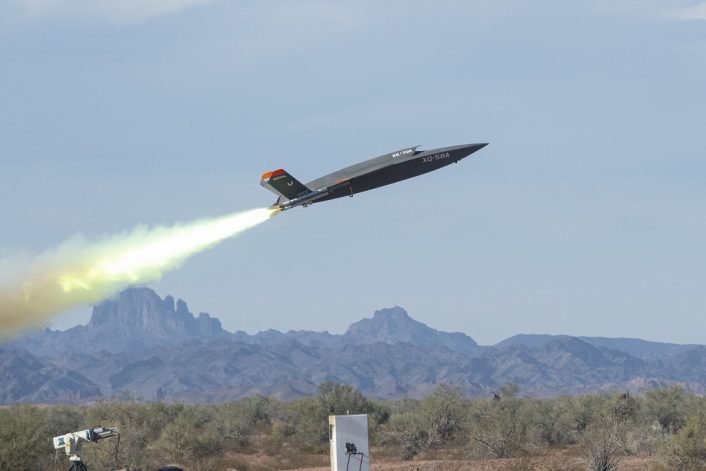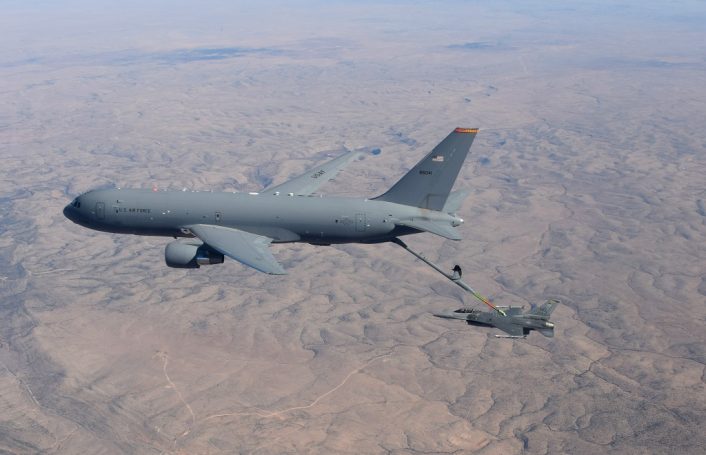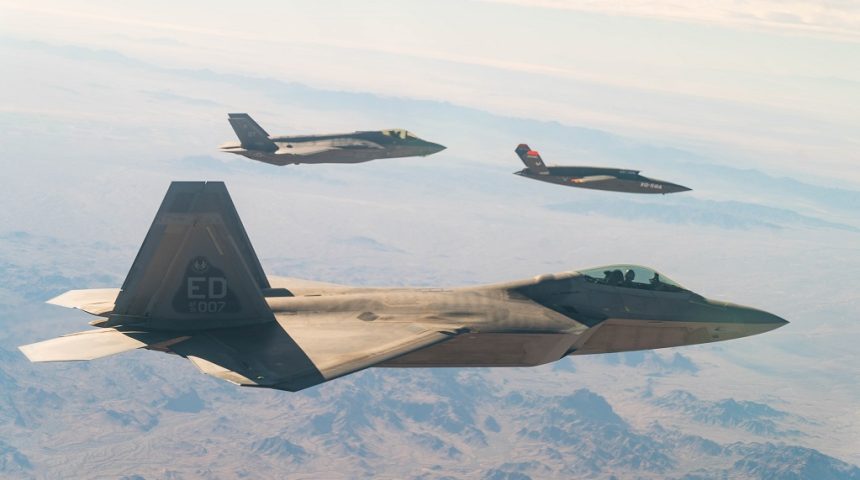The new ABMS systems tested on the KC-46 and XQ-58 will act as a translation platform converting messages sent by each aircraft in its native language.
The U.S. Air Force 5th generation fighter aircraft, the F-22 Raptor and the F-35 Lightning II, have always struggled to talk to each other. As part of their low-observability features, each jet has its own Low Probability of Detection/Low Probability of Interception (LPD/LPI) communications systems, respectively known as Intra-Flight Data Link (IFDL) and Multifunction Advanced Data Link (MADL). Each system uses its own “language”, which is not compatible with the other one, resulting in the F-22 being able to talk only with other F-22s and the F-35 being able to talk only with other F-35s.
Obviously, by “talking” we don’t mean verbal radio communications (that happens on U/VHF radio channels that can be also encrypted), but sensor data sharing. Initially the F-22 was reportedly scheduled to be upgraded with the same F-35’s MADL, but that never happened. The only similar system used by both aircraft is the Link 16, which however, is a legacy system that can’t be use to share the most sensitive date. Moreover, it uses a different language, requiring a translation before the message can be sent. Furthermore, only recently the Raptor obtained the full compatibility with Link 16, as for a long time it was relegated to a receive-only capability because transmitting a Link 16 message from an F-22 could reveal its position.
The USAF is developing the Advanced Battle Management System (ABMS), a cloud-based data sharing network to connect U.S. forces during Multi-Domain Operations (MDO) across land, sea, space, and cyberspace, allowing a joint force to use cutting-edge methods and technologies to rapidly collect, analyze, share information and make decisions in real time in future battlefields characterized by information saturation.
The program, overseen by the Air Force’s Rapid Capabilities Office, is testing and evaluating many new technologies. One of them, which was recently tested on December 9 at Yuma Proving Ground, Arizona, after preparatory tests at Nellis Air Force Base, Nevada, is gatewayONE, installed on the attritableONE XQ-58A Valkyrie UAV and tested in flight with an F-22, an F-35A and a USMC F-35B.
GatewayONE is a payload primarily designed to translate between MADL and IFDL, allowing F-35 and F-22 to communicate in their own native secure digital language and removing the current limitations imposed by legacy tactical data connections.
In addition to that, gatewayONE can move data from an operations center or tactical ground node into the cockpit of aircraft operating in a multi-domain battlespace while also sending the position data of each platform outside of the aircraft’s close-proximity formation to battle managers on the ground or in the air that can now better orchestrate operations. During the test, the gatewayONE payload also passed tracks or cues from ground operators to both fighters and passed a cue from the F-35A to the F-22 for the first time in the platforms’ native languages.
“The gatewayONE payload really showed what’s possible and helped us take a big step towards achieving (Joint All-Domain Command and Control),” said Lt. Col. Eric Wright, a 59th Test and Evaluation Squadron F-35 pilot. “This critical capability provides additional connections between our advanced fighters and other forces and battle managers across all domains. The future is promising, and gatewayONE will allow the F-22 and F-35 to connect to and feed data sources they’ve never before accessed. Those future connections will bring additional battlefield awareness into the cockpit and enable integrated fires across U.S. forces.”

The flight test involving the XQ-58 Valkyrie represents the first semi-autonomous flight of the UAV alongside the F-22 and F-35s. The gatewayONE payload integrated into the Valkyrie was at its maiden voyage with the fifth-generation fighters. According to the official USAF press release, shortly after takeoff, the communications payloads lost connectivity and those test objectives were unable to be accomplished. However, out of 18 test objectives, nine were successfully achieved. The Valkyrie met 80% of the overall flight test objectives with 100% of the formation flying objectives being met before safely landing in the Arizona desert, according to AFRL XQ-58A Program Manager, Michael Wipperman.
“Testing is all about pushing the limits of what’s possible, finding out where the toughest challenges are, and adapting creative solutions to overcoming difficult problem sets,” said Lt. Col. Kate Stowe, gatewayONE program manager. “The real win of the day was seeing the gatewayONE establish a secure two-way translational data path across multiple platforms and multiple domains. That’s the stuff ABMS is all about.”
According to Will Roper, Assistant Secretary of the Air Force for Acquisition, Technology, and Logistics, the problem that prevented the Valkyrie from achieving all the test objectives originated during the rocket-assisted takeoff. “We think we had a connector that came loose during it because the gateway itself was fine when the Valkyrie landed. So [it’s] a thing we’ve learned from and we’ll fix next time. Next time we get out, flying in the next on-ramp, we’ll probably check those soldering points more than one time.”
Even if the test suffered this setback, a land-based version of gatewayONE was present during the exercise and it appears that this was the one that performed the F-22/F-35 direct communication test in the end. According to DefenseNews Valerie Insinna, the December 9 test appears similar to the one performed during the first ABMS on-ramp demonstration/exercise last year, which involved radio systems, built by F-35 prime contractor Lockheed Martin and Northrop Grumman, linked to specific antennas built by Honeywell, to speak across both MADL and IFDL. During the test, both the F-22 and F-35 flew over the test rig and exchanged data by bouncing it back-and-forth from the ground-based radios.
The “translation rig”, as it was defined, was then scheduled to be installed on the XQ-58 for the next test. While not confirmed, it is possible that the same companies are also responsible for the airborne variant of gatewayONE. According to Air Force Chief Architect Preston Dunlap, the next test for the attritableONE/gatewayONE duo is scheduled to happen during the next ABMS demonstration in May 2021.
“The gatewayONE payload really showed what’s possible and helped us take a big step towards achieving (Joint All-Domain Command and Control),” added Lt. Col. Eric Wright, a 59th Test and Evaluation Squadron F-35 pilot. “This critical capability provides additional connections between our advanced fighters and other forces and battle managers across all domains. The future is promising, and gatewayONE will allow the F-22 and F-35 to connect to and feed data sources they’ve never before accessed. Those future connections will bring additional battlefield awareness into the cockpit and enable integrated fires across U.S. forces.”

The press release also mentioned additional successful tests performed during the week which included establishing a communications pathway between the KC-46 Pegasus tanker and a ground node using commercial internet routing standards over the Tactical Targeting Network Technology waveform and the F-35B sending full-motion video to a ground controller.
Moreover, the KC-46 is scheduled to become the first aircraft to receive systems developed as part of the ABMS program. Roper announced in fact that the Pegasus will receive a new pod known as ReleaseONE, capable of creating a local cloud network with tactical aircraft in the vicinity of the tanker to share orders created by artificial intelligence algorithms specifically for each mission after elaborating big data packages received from all sensors and shooters across the joint force.
“As a formal program, with a baseline and schedule, you’ll be able to see a mini-internet instantiated in our mobility fleet, our tankers, that’s connected back to the cloud and analytics and AI that are pushing forward suggested courses of action,” Roper said.
The new pod, whose producer has not been specified, could be also carried by the KC-135 Stratotanker, according to Roper. The tankers will be able this way to relay info and translate them in the native language of MADL and IFDL for the 5th generation fighter’s use. The components of the system have been reportedly demonstrated and proven through the ABMS demos, with different podded form factors and related acquisition and sustainment concepts being reviewed by the Rapid Capabilities Office.
The end goal is making sure that the pods can connect to the new USAF multi-classification cloud while growing the tanker participation in combat, letting them serve in an important command-and-control role while they refuel aircraft just outside the high-threat zone of Anti Access/Area Denial (A2/AD) weapon systems that are likely to populate future battlefields.
“We have an opportunity with our tankers who will be airborne, where our mission is to support the tactical forces,” said Air Mobility Command boss Gen. Jacqueline D. Van Ovost. Why not have the capability to relay line-of-sight and beyond-line-of-sight links to ensure that our tactical forces have the intelligence and support that they need while they’re airborne? I’m looking at things that can slap on and transmit. It may be a podded solution that could do just about anything, so that I won’t have to modify every airplane. Every airplane accepts a pod. Then we just place the pods in areas of the world where we might need them, and make it simple for the crews to operate.”









